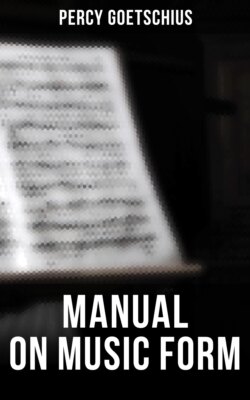Читать книгу Manual on Music Form - Percy Goetschius - Страница 13
На сайте Литреса книга снята с продажи.
[Illustration: Example 4. Fragment of Beethoven.]
ОглавлениеTable of Contents
The longer (heavier) tones are placed in the middle of the measure, between the beats; the tie at the end of measure 3 places the heavy note at the end, instead of the beginning, of the measure, and cancels the accent of the fourth measure. These irregular forms of rhythm are called syncopation. See also Ex. 6, second Phrase.
MELODY.—Any succession of single tones is a melody. If we strike the keys of the piano with two or more fingers of each hand simultaneously, we produce a body of tones, which—if they are so chosen that they blend harmoniously—is called a Chord; and a series of such chords is an illustration of what is known as Harmony. If, however, we play with one finger only, we produce a melody. The human voice, the flute, horn—all instruments capable of emitting but one tone at a time—produce melody.
Melody constitutes, then, a line of tones. If, as we have said, Time is the canvas upon which the musical images are thrown, Melodies are the lines which trace the design or form of these images. This indicates the extreme importance of the melodic idea in music form. Without such "tone-lines" the effect would be similar to that of daubs or masses of color without a drawing, without the evidence of contour and shape.
A good melody, that is, a melody that appeals to the intelligent music lover as tuneful, pleasing, and intelligible, is one in which, first of all, each successive tone and each successive group of tones stands in a rational harmonic relation to the one before it, and even, usually, to several preceding tones or groups. In other words, the tones are not arranged haphazard, but with reference to their harmonious agreement with each other. For a model of good melody, examine the very first sentence in the book of Beethoven's pianoforte sonatas:—
